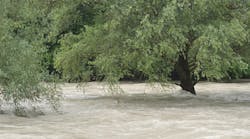Experts Say Weeds Contribute to Worsened Flooding Along U.S. Waterways
Scientists say the prevalence of invasive weeds may be a contributing factor to the extensive damage caused by heavy flooding this year across communities in the United States. Weeds are being found to overrun many vital “riparian” lands, or ecologically diverse habitats running along the country’s waterways that help to prevent or moderate flooding.
“Healthy riparian areas populated by native plants can store thousands of gallons of water per acre,” said Linda Nelson, plant physiologist with the U.S. Army Corps of Engineers and former president of the Aquatic Plant Management Society. “They filter the water that flows into a stream after a storm or snow melt and can also mitigate the effects of river flooding. But unfortunately the protection capacity of many of our vital riparian areas is being degraded by invasive weeds.”
Native plant species typical of a healthy riparian corridor have dense root systems to hold soil in place and protect against erosion. As a result, the soil is highly permeable and can absorb water entering the river and overflowing the banks. Healthy riparian land can even improve water quality as dense, native vegetation absorb potential contaminants and traps sediment.
The roots of weeds that overrun native riparian vegetation, such as knotweed, are far less dense than those of native plants and are unable to hold soil firmly in place. When knotweed invades a riparian zone, stream banks become unstable and soil is stripped away. This can shift a stream channel, create a sloping bank and result in significantly more sediment in the water. It also reduces the ability of both the riparian zone and the stream to hold water—promoting flash floods during periods of heavy runoff.
“Reclaiming riparian areas and restoring native species can be vital to flood control, water quality and even wildlife habitat,” said Timothy Prather, associate professor of weed science at the University of Idaho. “It is important that we focus on early identification of invasive weeds, understand their growth patterns and how they spread, and establish an effective management plan before it’s too late.”
Source: PRWeb



